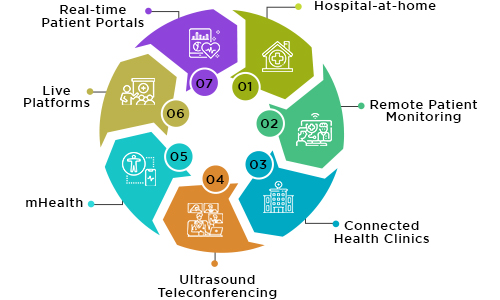Introduction:
Bang in the middle of a healthcare crisis, the COVID 19 pandemic has taught us many lessons. The healthcare sector has witnessed a struggling strain, and social distancing has become the new normal. With this calamity, virtual health care information systems have emerged as the need of the hour. Innovation opportunities in virtual healthcare technology have become a priority. A recent Frost and Sullivan study projected an exponential surge in growth opportunities of virtual care platforms.
In particular, virtual health care information systems are now emerging as the way forward. With virtual integrated care solutions that are scalable and meticulous, healthcare software product development is poised to address the needs of the current healthcare environment. As more than half of U.S. hospitals have adopted virtual healthcare technology and with a global valuation of 20% annual growth in telemedicine, healthcare organizations need to, quite literally, get with the program. Custom healthcare software development with a virtual care platform will ensure a pathway into the future of healthcare.
Benefits of Virtual Health Systems
The adoption of virtual healthcare solutions offers the following advantages,
- Improved patient outcomes with reduced costs
- Reduced burden on medical staff
- Minimized spread of infection
- Population risk assessment through predictive analysis
- Continual monitoring of patients through remote accessibility
- Increased patient empowerment, patient engagement, and education
- Remote monitoring to reduce hospital readmissions
- Increased efficiency of clinical staff
- Increased care coordination
- Reduced hospital stays
- Reduced death rate
- Reduction in emergency visits
OSP’s Telehealth Solution
A US-based company approached OSP to help build a modern-age health system care management software, including virtual health applications. They wanted to create advanced telehealth solutions and a chatbot that would include patients and their families in the entire process. The applications would also simplify the care process for patients with chronic diseases and senior citizens.
Our remote health monitoring system offered the following advanced solutions:
- Patient vitals can be obtained via medical devices integrated with digital health tech
- Patients would be aware of their daily health data to motivate self-care
- Nutritional intake information to enable patients to maintain fitness targets
- Providers can add new medications and track previous prescriptions
- Patients receive timely reminders to consume medicines or supplements
- Patients get health access to doctors of their choice through virtual consultations
- Real-time communication with healthcare providers using the secure chat platform
- Family members of at-risk patients can receive SOS alerts in emergencies
- API supports third-party integrations with electronic records and other open platforms
- API promotes the user-friendly utilization of these integrations
- Supports viewing of patient data from various sources from any smart device
- Physicians can keep tabs on patient health through the real-time vitals
- Physicians receive alerts and notifications of any changes or shifts in health
- Patients can connect with and build communities to share activities and daily updates
7 Vital Virtual Health Systems

1. Hospital-at-home
The hospital-at-home model is a caregiving solution, empowered with virtual care solutions for hospitals and automated innovations. These automated healthcare solutions offer a comprehensive approach toward operations that allow for health care management through patient engagement systems; with additional services to motivate patients toward healthier choices and technologies to enhance labor efficiency, a holistically improvised approach is established.
The features of the program include:
- By adopting automated services for data visualization and decision support tools, ICUs can successfully reduce the length of patient stay and increase mortality rates. With a proactive model, advanced telehealth solutions work toward reducing the burden on physicians and nurses by automating clinical processes.
- The need for increased efficiency in surgical units has been a long-standing requirement, and telehealth software platforms allow for telehealth-based analysis of patient health in the surgical units. Integrated telehealth solutions use audio-visual access to patient rooms and other innovations that reduce readmission and increase patient satisfaction and clinical outcomes.
- Consultation services are empowered to be offered virtually and reduce travel time for patients while providing easier accessibility to physicians through telehealth systems.
- A care team connects chronic patients through integrated healthcare solutions with personalized treatment plans and in-home patient monitoring. Readmission causes are identified, addressed, and subsequently reduced.
2. Remote Patient Monitoring
This system is the essential accessibility that allows patients to easily engage with their physician and other clinicians through virtual enablement for continual caregiving through patient engagement solutions. Patient accessibility is enhanced through electronic data interchange on their devices. Furthermore, mobile telehealth solutions can be deployed in offices, nursing homes, rural clinics, schools, etc. This diminishes healthcare access hurdles, such as physical commutes, appointment hassles, etc., through video conferencing services on mobiles, tablets, and other devices.
Remote patient monitoring is pivotal, wherein the care provider can monitor and gauge the patient’s health from a virtual purview. It also empowers patients to take their health into their own hands. Physiological characteristics and regular updates of vitals can be progressively tracked for timely assistance through patient engagement solutions. The care providers can intervene in urgent cases through advanced technologies.
Other features include:
- Care transition patient and family engagement
- Personalized monitoring for chronic conditions
- Continual access to virtual care through personal devices
- Patient education and social support
- Automated medication reminders and trackers of intake
- Home-based care for senior citizens
3. Connected Health Clinics
This is a virtual health system that establishes a 2-point connection. Usually, this connection is between a larger, urban healthcare organization and a smaller, usually remote, health center or clinic. The smaller healthcare facility is provided with increased facilities through its association with the larger entity. The latter can offer improved services through this connected patient engagement platform from specialist caregiving to advanced technologies.
Generally deployed through high-speed internet connectivity, urgent care facilities are further enhanced, along with radiology and practice management solutions. A common practice is establishing network programs that offer this connection between larger hospitals and smaller clinics. There are currently over 200 such programs that have assisted the elevation of over 3000 clinics in remote areas. Patients’ access to health in these remote areas is dynamically increased through such connections.
4. Ultrasound Teleconferencing
As the world of telemedicine software is expanding across multiple healthcare organizations, several new and distinguished care services are being developed on this platform. An innovative way to offer remote diagnosis and provide interactive care is a real-time ultrasound facility conducted through teleconferencing. In essence, this allows experts to access ultrasound exams from anywhere through cloud computing in healthcare.
This telemedicine software serves as a significant boon for rural facilities with limited capacity by enhancing their quality of care without the need to transport the patient physically. It significantly reduces delays and expenditure, thereby increasing patient satisfaction. Furthermore, virtual health clinical integration enhances collaboration between clinicians through smart devices for live interactions. The clinicians involved can view the ultrasound image, engage in probe positioning, and interact while doing the same.
5. mHealth
Mobile health offers a holistic solution that is accessible to anyone, everywhere. It is a web-based patient engagement platform that can be deployed on mobile applications to allow physicians to connect with their patients remotely and comprehensively. Patients’ medical information is gathered, stored, and processed for efficient caregiving. The patient’s data is then used meaningfully, through medical informatics, to make caregiving as accessible as possible. This patient engagement technology empowers patients to take charge of their health.
A virtual health system that offers innovative approaches toward patient education and engagement can go a long way in improving the positive outcomes of healthcare facilities. A live and interactive platform allows for improving key metrics that rely on patient satisfaction and quality outcomes with increased reimbursements. Distinct features of the solution include:
- Continual education and information to patients and associated family
- Clinical services, virtually offered, for treatment and recovery
- Enhanced experiences for patients through comprehensive information offering
- Discharge planning information
- Extensive planning and treatment plans
- Automated workflows and documentation through EHR
- Interoperability for holistic caregiving
- Simplified workflows
- Advanced customization of treatment plans
The platform allows continual and on-demand interaction between the patient and the physician. Other accessible avenues are social media and online communication platforms. This branch of a patient management system is well-suited toward nonurgent care, such as psychiatry. Telemedicine pharmacy solutions can be further deployed to provide prescription access and monitoring.
6. Live Platforms
A virtual health system that offers innovative approaches toward patient education and engagement can go a long way in improving the positive outcomes of healthcare facilities. A live and interactive platform allows for improving key metrics that rely on patient satisfaction and quality outcomes with increased reimbursements. Distinct features of the solution include:
- Continual education and information to patients and associated family
- Clinical services, virtually offered, for treatment and recovery
- Enhanced experiences for patients through comprehensive information offering
- Discharge planning information
- Extensive planning and treatment plans
- Automated workflows and documentation through EHR
- Interoperability for holistic caregiving
- Simplified workflows
- Advanced customization of treatment plans
The platform allows continual and on-demand interaction between the patient and the physician. Other accessible avenues are social media and online communication platforms. This branch of a patient management system is well-suited toward nonurgent care, such as psychiatry. Telemedicine pharmacy solutions can be further deployed to provide prescription access and monitoring.
7. Real-time Patient Portals
The current COVID 19 pandemic has created a unique patient experience software that works with patient portals to create a comprehensive record for holistic and accurate diagnosis through real-time patient engagement technologies. This novel experiment is geared toward raising a new concept called Open Notes. Generally, medical staff is expected to fill in patient information upon arrival at the facility. However, this new method allows for combinatory support that involves pre and post notes by the patient and providers alike. Therefore, patient portals are an excellent tool for faster and more accurate diagnoses.
Conclusion
Real-time telemedicine software platforms have displayed the ability to provide continual care to patients from their own homes efficiently. Elderly patients and chronic illnesses have benefited greatly from the virtual features offered through remote patient monitoring solutions. This innovation will continue to develop into multiple avenues of medicine, such as psychiatry, dermatology, ophthalmology, etc.
OSP is a trusted software development company that delivers bespoke solutions as per your business needs. Connect with us to hire the best talents in the industry to build enterprise-grade software.

How can we help?
Fill out the short form below or call us at (888) 846-5382
Looking for software solutions to build your product?
Let's discuss your software solutions for your product in our free development acceleration call!
Get In Touch arrow_forwardDiscuss Your Project Handover with a team of expert Book a free consultation arrow_forward
About Author

Written by Riken Shah linkedin
Riken's work motto is to help healthcare providers use technological advancements to make healthcare easily accessible to all stakeholders, from providers to patients. Under his leadership and guidance, OSP Labs has successfully developed over 600 customized software solutions for 200+ healthcare clients across continents.

















